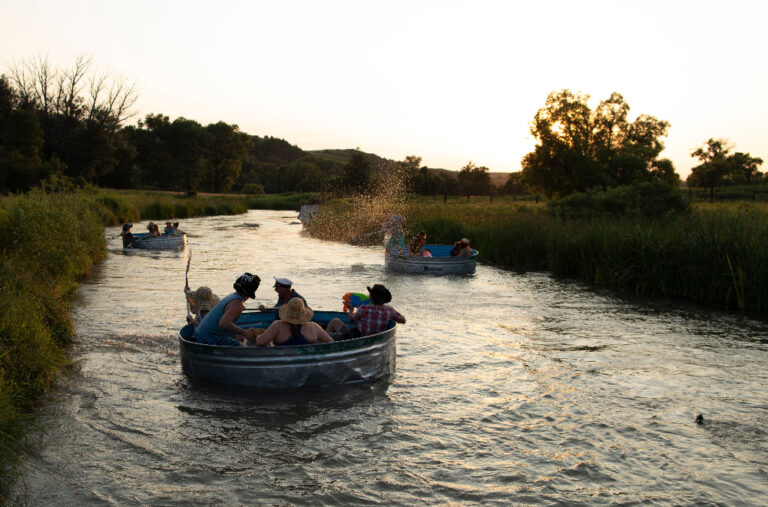Mount Rushmore and the Great Lakes are a couple of the Midwest’s tourism magnets, but some states have to work against their reputations to attract visitors. They’re getting creative by highlighting amenities that can be a bit off the beaten path.
Listen to this story here.
Climbing into a cattle water tank and floating down a river may seem an odd way to spend an afternoon, but in Nebraska “tanking” is a summer pastime.
The tanks, usually metal or plastic and about 8 feet in diameter, provide plenty of room for picnic tables, coolers and entire families.
Now they may include something else: tourists.
Nebraska’s Tourism Commission is pitching tanking as just one reason for people to add the state to their vacation list. The quirkiness goes hand in hand with the state’s tourism slogan: “Nebraska. Honestly, it’s not for everyone.”

While Illinois has Chicago and Missouri the St. Louis Arch, other Midwestern states without obvious destinations – such as Nebraska, Iowa and Kansas – have to work a little harder for tourism dollars.
For example, while the off-beat campaign helped Nebraska boost its pre-pandemic 2019 traveler spending to $3.5 billion, it pales in comparison to Illinois’ 2019 figure of $43.1 billion or Missouri’s $17.7 billion.
Having room to grow isn’t necessarily a problem, according to Dipra Jha, a hospitality business management professor at Washington State University. He said it’s a chance for tourism directors to get more creative with how they draw in visitors.
“These states are true tourism underdogs,” Jha said. “They’re less discovered, so there’s a sense of mystery about them. There’s an opportunity there to find something unique and build a reputation.”
Nebraska tourism director John Ricks said states should lean on eccentricity and unexpected treasures to counteract attitudes of what there is to do in the heartland.
He has his work cut out for him – when Ricks surveyed folks on what they thought of Nebraska, he said it got a bit rude.
“They were almost like knee-jerk responses,” he said. “‘No fun, flat and boring landscape, nothing to do blah, blah, blah, blah, blah.’”
Iowa and Kansas combat similar beliefs. These states have to go beyond the stock images of skylines, friends laughing in bars and trekking up hiking trails and appeal to travelers who want to discover and explore new places.
“We’re just trying to rise above the level of sameness that a lot of tourism spots are, they all start to kind of look the same,” Iowa Tourism’s communications manager Jessica O’Riley said. “So we really wanted to find a way to break through that clutter.”
Iowa advertises its showy state fair, which boasts things like the famous butter cow sculpture, and the Field of Dreams, the site of the movie and more recently, a couple of Major League Baseball games. The state also highlights the biking paths that host RAGBRAI, the annual eight-day bike ride/party across Iowa.

Kansas promotes working ranches that moonlight as bed and breakfasts and its endless sunflower fields. And don’t forget the brisket, said Kansas tourism director Bridgette Jobe.
“Our barbecue stands up to any other barbecue anywhere,” she said. “Everybody has their favorite place and we will fight for that. And I love that, it’s one of those things that makes Kansas very special.”
Those types of perks give people a reason to look past their perceptions and try out the Midwest, Ricks said.
“You have to give people a really good reason why your state is different and intriguing,” he said. “Tell them that part, don’t tell them you got good restaurants and breweries, because those are things everybody has. Give them the unique reason why they should try out Nebraska.”

Jha said this strategy also comes down to using honesty to connect with the right type of tourist. Most visitors aren’t coming to the Midwest to live it up in cities buzzing with bars and shopping centers, and it could seem disingenuous for the heartland to pitch urban amenities.
“People are savvy enough to know what is plastic and what is authentic,” he said. “Highlighting nightlife in your small rural town will not make sense. But highlighting the endless sky and miles and miles of farmland for someone who wants to get out of New York City can be really attractive and authentic.”
Data from the tourism offices show the off-beat marketing may work. Before the pandemic shut down travel, visitor spending had been increasing steadily in each of the three states since 2016.
And O’Riley said once people start exploring Iowa, they’re not talking about “flyover country” anymore.
“We’re seeing that the perception of Iowa is changing. And the likelihood to visit it is increasing as well,” she said. “So we know if we can get Iowa in front of people, their eyes open like, ‘Oh my gosh, I had no idea. There was all this stuff hiding right here, and I just never knew about it.’”

While the pandemic brought tourism to a halt everywhere, a silver lining followed for states with wide open spaces. For people who want to stay away from crowds, get into nature and off of Zoom, the Midwest has lots to offer.
And Midwesterners shouldn’t be shy about talking their states up, Jobe said.
“It’s okay for us to tell others how wonderful we are; it’s just not in our nature to do so. We know we’re a great state,” she said. “We just have never had that ability or that desire to proclaim that to the rest of the world. And we’re trying to change that.”
Follow Elizabeth on Twitter: @Ekrembert This story was produced in partnership with Harvest Public Media, a collaboration of public media newsrooms in the Midwest. It reports on food systems, agriculture and rural issues. Follow Harvest on Twitter: @HarvestPM

